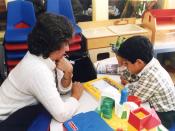The article Effective Inclusion Professional Development in the Context of the Classroom was written by Howard M. Weiner and appeared in TEACHING Exceptional Children, Vol. 35, No. 6 pp. 12-18. July/August 2003. In this article, the author discussed Inclusive Education Teacher Support to meet the needs of all students. He explains that one of the most powerful ways teachers can change the culture of a school is to alter the way students are treated. When teachers volunteer to integrate the general education environment with students who were previously segregated in special education classrooms, beliefs, values and behaviors can change significantly.
The author further describes District 24 Inclusive Education Teacher Support Program. In this large urban, K-8 school district, teachers in inclusion classes received a dynamic staff development program and reported changes in attitudes and practice. Also, teachers in schools that were comfortable with various forms of tracking are starting to reflect upon what their priorities should be after a group of their colleagues created exemplary inclusion classrooms.
Furthermore, Weiner states that in this program, Master teachers (inclusion facilitators) provided support for volunteer inclusion teachers. They met with teachers before, after and during school to discuss values, beliefs and teacher- defined issues. In addition, teachers received extensive in-classroom training on effective use of research-based teaching strategies. Even by criteria that would impress the public and school administrators, the inclusion program was successful.
Statistically significant and meaningful improvements were made by both general education and special education inclusion class students compared to cohorts in non-inclusion classes. Comparisons were made using 2001 vs. 2000 city and state standardized reading tests in grades three through eight. Weiner gives comparison charts.
The author categorizes the learning environment and school culture into three different levels of inclusion. The Level I School is best referred to as...



Good thoughts
your thoughts were good but you could have done a little better job of proof reading, or having someone else proof read for you. some of the grammar is incorrect and your intro should grab a little more attention than it did. but nice thoughts over all
~Katy
4 out of 4 people found this comment useful.